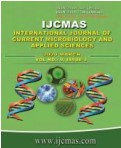


 National Academy of Agricultural Sciences (NAAS)
National Academy of Agricultural Sciences (NAAS)

|
PRINT ISSN : 2319-7692
Online ISSN : 2319-7706 Issues : 12 per year Publisher : Excellent Publishers Email : editorijcmas@gmail.com / submit@ijcmas.com Editor-in-chief: Dr.M.Prakash Index Copernicus ICV 2018: 95.39 NAAS RATING 2020: 5.38 |
Guava (Psidium guajava L; Myrtaceae) popularly known as “apple of tropics” is an important fruit crop of India. It is largely a self-pollinated crop, but cross-pollination also does occur. This results in a large variability in the seedling population. Among cultivars, substantial variation exists in terms of growth pattern, yielding behavior, fruit characters (peel, shape etc.) and physio-chemical composition, aroma, pulp to seed ratio, seed characters. Assessment of variability can be achieved through morphological characters, chemical composition and by biotechnological tools. Variability assessment morpho-agronomically can be done through descriptors by UPOV (1987), NBPGR (2002) and AICRP (CISH) Lucknow (2011). Broader variability in any crop offers good scope for breeding and improvement. About 160 cultivars are available in India, among which ‘Allahabad Safeda’ and ‘Sardar’ varieties are widely cultivated. Crop Improvemnet work attempted in India resulted in release of several superior selections/hybrids. Interspecific hybrids resistant to guava wilt were developed at CISH, Lucknow which are graft compatible with commercial varieties of P. guajava. Knowledge on genetic variability and germplasm could help in designing crosses, evaluation methods and breeding strategies.
 |
 |
 |
 |
 |